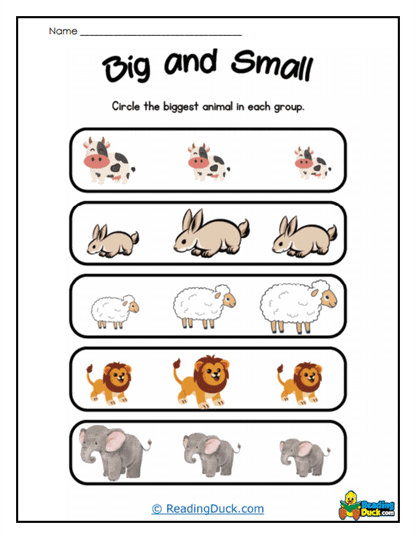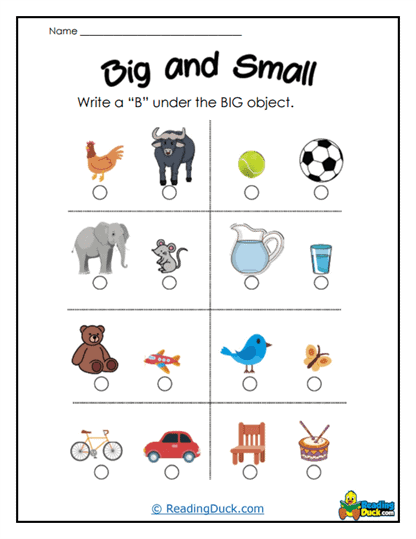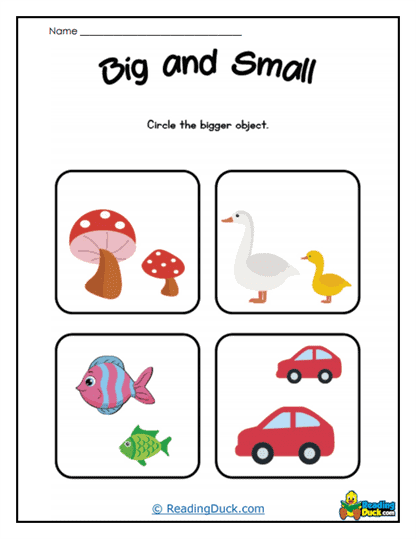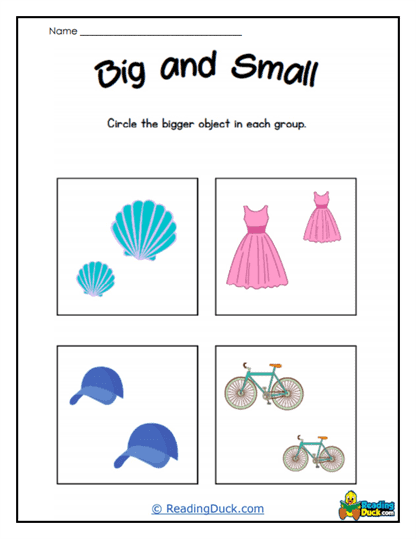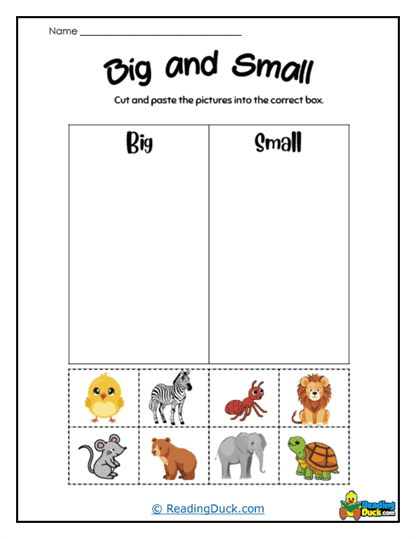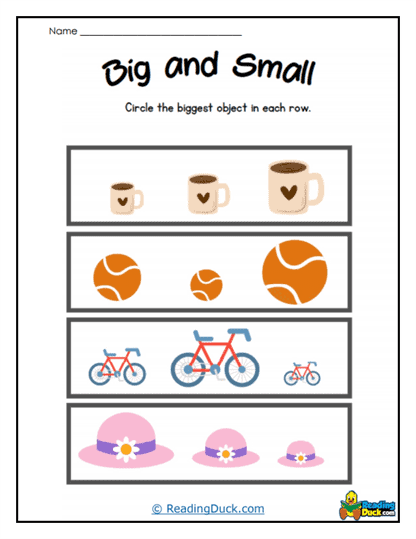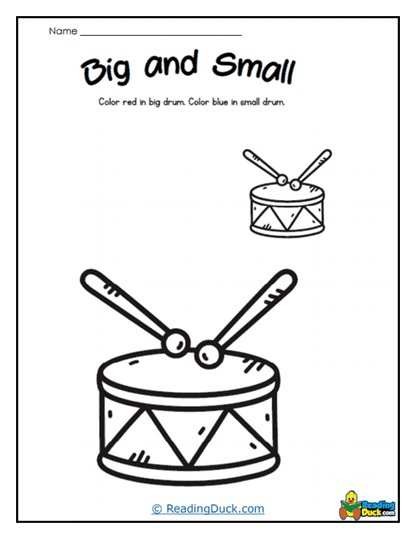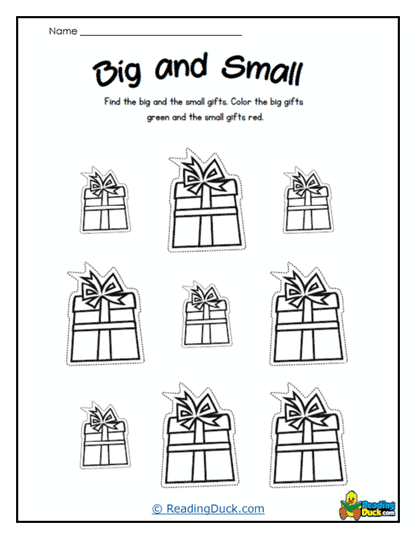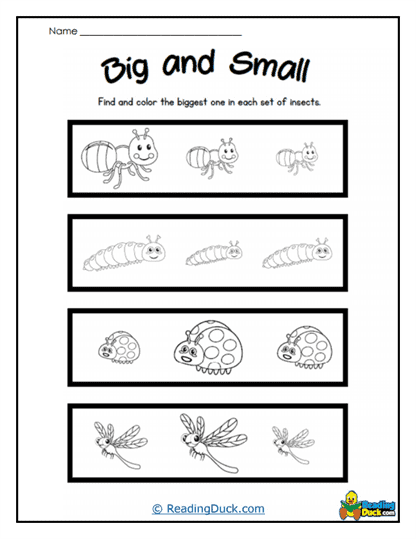Big vs. Small Worksheets
About Our Big vs. Small Worksheets
These worksheets will help young students understand the concept of size comparison. These worksheets use visuals of different objects, animals, shapes, and other familiar items to create engaging activities that allow children to identify, compare, and categorize items by their size. Through exercises that ask students to determine which object is bigger or smaller, these worksheets introduce foundational mathematical thinking, specifically in areas like measurement and comparative analysis. They also help students build observation skills by visually assessing the relative sizes of objects.
The primary purpose of big vs. small worksheets is to introduce size comparison in a way that is accessible and relatable for young learners. By seeing items side by side or grouped together, students start recognizing the relationships between different objects based on their dimensions. For example, they might see a picture of a chicken next to a cow and intuitively understand that the cow is the larger animal. Through repeated practice, students begin to grasp that comparing size is a method of understanding numerical or quantitative differences.
The worksheets shown in the provided images offer a range of comparison activities. Some focus on placing a mark under or next to the larger item, while others introduce more complex tasks, like ordering objects from smallest to biggest. This progression allows students to develop their comparison skills gradually, from identifying the larger of two items to arranging multiple items by size, which strengthens their understanding of sequencing and ordering.
The worksheets serve as a building block for later math skills. By familiarizing students with concepts like "bigger than" and "smaller than," they lay the groundwork for understanding measurements, quantities, and numerical comparison. These worksheets encourage students to think critically about size, fostering spatial awareness and basic arithmetic reasoning. Using relatable imagery of animals, toys, and household items, these worksheets make learning engaging and relevant.
Types of Exercises
This collection of worksheets include a variety of exercises tailored to different learning stages and skills. One common activity involves choosing the bigger object from a set of two or more images. In one worksheet example, students are asked to write a “B” under the big object, as seen in the images of animals, household items, or toys. This simple activity allows young learners to practice recognition and comparison without needing complex instructions, making it ideal for beginners.
Another popular exercise type is arranging objects in order of size. For instance, one of the worksheets shows students a set of three objects, like apples or mugs, and asks them to label each with a number indicating size order (smallest to biggest). This task not only reinforces the concept of size comparison but also introduces sequencing, which is essential for understanding numerical order and patterns. This type of exercise encourages children to think beyond a single comparison and develop a broader understanding of progression in size.
Some worksheets focus on classification, where students cut and paste pictures into categories like “Big” and “Small.” This hands-on activity is particularly engaging, as it combines fine motor skills with cognitive processing. By physically sorting objects into size categories, students strengthen their ability to classify based on visual criteria. For example, they might place a picture of a lion in the "Big" category and a mouse in the "Small" one, reinforcing their understanding of relative size through active participation.
Certain worksheets incorporate more challenging comparison tasks, such as identifying the smallest object in a group or coloring the biggest object in a set of similar items. These exercises encourage attention to detail and promote observation skills as students need to carefully assess each item. The varied activities allow educators to scaffold learning, moving from basic identification tasks to more complex sorting and ordering exercises, thus building confidence and competence progressively.
Skills Gained
By completing our big vs. small collection, students acquire a range of valuable skills that go beyond simple size comparison. First and foremost, they develop critical thinking skills by learning how to make judgments based on visual information. Each exercise requires students to observe and analyze objects, determining which is bigger or smaller, and this process sharpens their decision-making abilities. Such skills are foundational in math and science, where observations often lead to conclusions or solutions.
Another important skill fostered through these worksheets is spatial awareness. Understanding the spatial relationship between objects, such as their relative sizes, is essential for geometry and other math disciplines. When students regularly practice determining the size of objects, they become more comfortable visualizing and comparing spatial properties, which is beneficial in various academic and real-world settings.
These worksheets also enhance problem-solving abilities. Many of the exercises present students with small challenges, like choosing the largest item in a group or arranging items by size. This kind of practice encourages students to think critically and methodically about how to approach a task, honing their problem-solving skills. Additionally, hands-on activities like cut-and-paste sorting engage fine motor skills, which are crucial for early childhood development, supporting everything from writing to art.
These worksheets contribute to a child's understanding of mathematical concepts such as greater than, less than, and equal to. By repeatedly comparing objects, students gain familiarity with these comparative ideas, building a strong foundation for future math lessons on measurement, place value, and fractions. The confidence they gain through mastering these early math concepts helps prepare them for more advanced studies, giving them a head start in numerical literacy.
Real-World Applications
The ability to understand and compare sizes has numerous practical applications in everyday life. One of the most immediate uses is in shopping, where students learn to compare quantities and prices to determine the best value. For example, understanding that a larger bottle of juice may offer more value than a smaller one at a similar price allows them to make informed choices. Skills gained from Big vs. Small Worksheets help build this foundational understanding of size and quantity.
In cooking, comparing sizes is essential for measuring ingredients accurately. Recipes often call for specific amounts, and recognizing the difference between a teaspoon and a tablespoon, or a cup and a pint, requires a sense of size and measurement. The comparisons practiced in Big vs. Small Worksheets give students an early sense of these distinctions, which can later be applied in cooking, baking, and other household tasks.
In addition, many real-world scenarios involve spatial awareness and comparison. For instance, when arranging furniture in a room, people often need to decide if certain items will fit or if they are too big or small for the space. The skills developed through Big vs. Small Worksheets give children a foundational understanding of how to judge sizes, making it easier for them to tackle spatial reasoning tasks, both as children and later in life.
These worksheets lay the groundwork for more advanced analytical skills used in fields such as science and engineering. In science, for instance, comparing sizes of objects is fundamental when observing different species or analyzing data. Similarly, engineers need a keen sense of spatial awareness and comparison for designing structures or creating products. While these worksheets may seem simple, they introduce concepts that are essential in a variety of professions, making them a valuable tool for lifelong learning.
